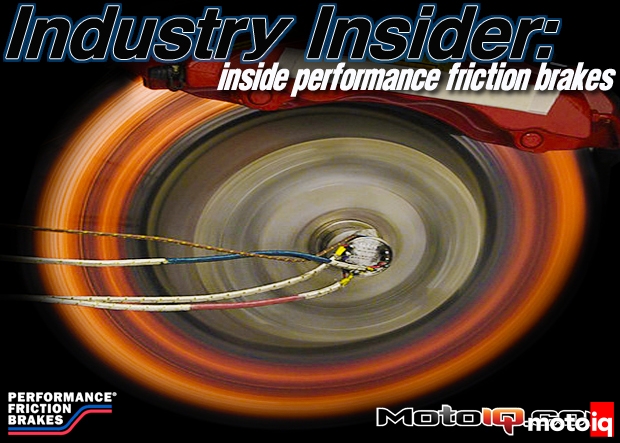,
 |
| Performance Friction rotors and calipers on the FXMD NSX. Believe it or not, this is a street system. It works really well for racing use. The only real difference are the dust seals. |
One of the most interesting features is the use of 4 small brake pads per caliper, one for each piston. This prevents taper wear of the pads. The small, independent pads and pistons ensure nearly equal hydraulic and braking force distribution, not only on the brake pads but throughout the caliper body alsol. This enables the caliper body to be pared down without sacrificing stiffness. The 4 smaller pads also have 4 leading edges, important because the leading edge of any pad produces the greater part of braking force due to the tipping moment created as the brakes are applied. This gives greater bite than conventional calipers and pads. The 4 pad calipers are not legal for all forms of racing so Performance Friction also makes conventional 2 pad calipers too.
 |
| You can see many of the caliper details here. The caliper doesn’t have unusually large pistons, those are piston caps. The pistons are deep inside the caliper body where they are isolated from heat. There is a heat shield between the piston caps and the piston to keep heat out of the brake fluid and away from the seals. The piston cap distributes brake force across the pad better and also shields the piston from grit. You can also see the stainless steel pad abutments that protect the caliper body from the pads. You can also see the CNC machining that lightens the caliper. |
The caliper pistons are unique as they are buried deep within the calipers body, isolated from heat and protected from debris. A large diameter cap covers the piston and provides a large surface area for the pad to bear upon to better distribute the braking force. A heat resisting shield made of a secret space age material separates the piston cap from the actual piston and greatly reduces heat transfer to the brake fluid.
On the street versions of the caliper, a full bellows type dust boot prevent contaminants from coming near the seals. For racing use the bellows are omitted which is standard practice for all racing calipers as it would be destroyed by racing levels of heat. The seals geometry is designed to optimize piston retraction to assure cool, drag free operation. The caliper’s forged body has stainless steel abutments for the brake pads to ride in to assure smooth application, low wear and positive pad retraction without bind. Their abutments are aligned with the direction of brake force induced torque to reduce overall stress and flex within the caliper and mounting system.
 |
| A look at Performance Friction’s unique 4-piston, 4-pad caliper design. |
Another innovative feature is pad retractors. Pad retractors are an option on some performance friction race calipers. A pad retractor pulls the pad away from the rotors surface by a consistent slight amount as the pad wears. The retractors eliminate pad drag on the straights allowing the pad to run cooler and to reduce rolling resistance. They also make the brake system less sensitive to piston knockback. Performance Friction’s pad retractor is an allen bolt that is threaded into the pads backing plate. A stack of Belleview type washers are supported by a proprietary carrier that has a tight interference fit on the allen bolt’s shank. The washer stack provides the consistent retraction distance and the carrier slides on the bolt shank as the pads wear to serve as a self adjusting stand off for the washer stack. When the pads are replaced the carrier must be tapped back to the starting position.
 |
| The 4-piston caliper installed on a car. You can see more of the CNC lightening machining here. |


